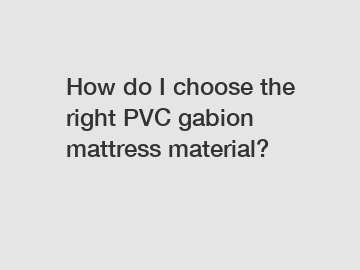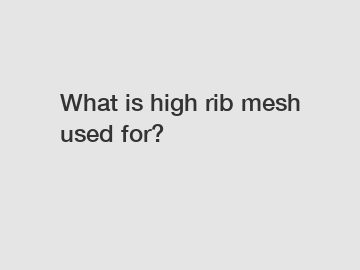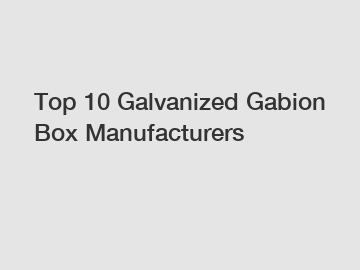Hardware Cloth: What Is It? How Is It Made? Types, Uses
May. 20, 2024
Hardware Cloth: What Is It? How Is It Made? Types, Uses
Hardware Cloth
Contact Companies
Please fill out the following form to submit a Request for Quote to any of the following companies listed on
Click here to get more.
Get Your Company Listed on this Power Page
Introduction
This article takes an in depth look at hardware cloth.
You will learn more about topics such as:
- What is hardware cloth?
- How hardware cloth is made
- Uses for hardware cloth
- Types of hardware cloth
- And much more…
Chapter One – What is Hardware Cloth?
Hardware cloth is a woven mesh made by interlacing various sizes of wire to form a metal fabric that can be used for animal cages, fence material, strainers, and filtering screens. The differences between the various types of hardware cloth are determined by the type and gauge of wire, the kind of finish, and how the metal wire fibers are joined at their intersections.
As with any type of wire, the higher the gauge of hardware cloth, the smaller the wire will be. The most common gauges of wire used to make hardware cloth are 16, 19, 23, 24, and 27, with 16 being the largest and thickest.
Chapter Two – How Hardware Cloth is Made
Hardware cloth is formed by parallel rows of wire intersecting with columns of wire. Though it may be presumed to be similar to perforated metal or expanded metal sheets, its production is far different. Hardware cloth is produced using a wire fabricating process and can be made from any size wire with smaller wire gauges being preferable.
A major difference between the types of hardware cloth is how the wires are joined where they intersect. The two methods used to make hardware cloth are welding and weaving. In the welding method, the woven intersecting wires are placed in a welding machine that rapidly welds the intersections. Woven hardware cloth is constructed using the over and under technique used in the weaving of fabric cloth.
Making Hardware Cloth
Metals
Any type of metal wire can be used to produce hardware cloth. In most cases, manufacturers prefer stainless, carbon, or galvanized steel. For many years, hardware cloth was made exclusively of stainless or galvanized steel since they have exceptional durability and resistance to corrosion. In recent years, hardware cloth has been produced using various types of plastic coats, which has expanded the selection of metals.
Stainless steel hardware cloth is made using series 304, 304L, 316, and 306L, which are produced using plain and twill weaves.
Carbon steel is an ideal material for forming hardware cloth since it is so ductile; this enables it to form tight secure connections. Variations in the carbon content change the properties of carbon steel and enhance its use as hardware cloth. There are four types of carbon steel used for hardware cloth that are distinguished by the amount of carbon they have.
Low
Low carbon steel has 0.05% to 0.25% carbon and up to 0.4% manganese. Known as mild steel, low carbon steel is easy to shape and is carburized to increase its surface hardness.
Medium
Medium carbon steel has 0.29% to 0.54% carbon and 0.6% to 1.65% manganese. It is a strong ductile steel with long wear properties.
High
High carbon steel is exceptionally durable and strong with a carbon content of 0.55% to 0.95% and manganese content of 0.3% to 0.9%.
Very High
Very high carbon steel has a carbon content of 0.96% to 2.1%, which makes it extremely strong but brittle.
For many years, galvanized steel was the most common type of hardware cloth and was available everywhere. Though still a popular choice for the manufacture of hardware cloth, the advancements in metallurgy have made it just one of the many choices for the production of hardware cloth. The zinc coating on galvanized hardware cloth makes it resistant to corrosion and gives it a longer life.
Though stainless, carbon, and galvanized steel are widely used to make hardware cloth, every type of metal that can be shaped into wire can be made into hardware cloth.
The image below is of brass hardware cloth, which has excellent wear resistance with 80% copper and 20% zinc content.
Welded
The process of welding hardware cloth begins with drawing down the parallel columns and rows such that they intersect. The drawing down process forms the wires to the size of the openings prior to the welding process. The welding machine performs a parallel line of welds simultaneously where the rows and columns meet. The drawn down wire is continuously fed into the welding machine, welding each row as the wire moves through.
Woven
Woven hardware cloth is produced using a wide variety of techniques and methods. Some methods apply to a particular manufacturer who has proprietary rights over the process. Though there are several ways to weave hardware cloth, the basis of the process involves intertwining the wires by intersecting them using the over and under method that is used to weave cloth. The simplicity of the description is complicated by the variety of approaches.
Plain Weave
Plain weave is also known as square weave and is used to produce the majority of hardware cloth. The warped wire, wires that are parallel to the cloth, crosses above and below the weft wire, which runs perpendicular to the cloth. The warp and weft wires are of the same diameter and gauge.
Twilled Weave
In the case of the twilled weave, each weft wire passes alternately above and below every successive pair of warp wires. The twilled weave is used for heavier gauge wires, such as 16 or 19, that would not be possible with plain weave.
Dutch Weave
Two different size wires are used to create the Dutch weave. The warp wire is larger than the weft. The distinguishing feature of the Dutch weave has to do with how closely packed the weaving is; it makes the hardware cloth very dense with fine openings. There are several forms of the Dutch weave including reverse, twilled, and reverse twilled. Each of the variations creates different properties and characteristics in the final product.
Five Heddle Weave
The five heddle weave is produced by passing the fill wire alternately over and under five warp wires. The final appearance of the weave is parallel diagonal lines. The five heddle weave allows for the use of heavier wires, which allows the weave to support heavier loads.
The four weaves listed above are the most common weaves used to produce hardware cloth. There are several variations on these four basic weaves that include oblong, multi-layer, cable, spiral, and various combinations of each method.
Knitted
Knitting wire produces hardware cloth that has interlocking loops where the loops are hooked together to form a hive formation. The interlocking loop method of wire knitting produces hardware cloth that is durable, flexible, sustainable, and compressible such that it has a two way stretch capability. The equipment used to produce knitted hardware cloth is exactly the same as that used to make sweaters and scarves. The cloth can be made from flat or round wires with round wires being the most common and easiest to work.
Crimped
Crimped wire cloth is produced from ferrous and non-ferrous metals. There are several methods used to make crimped hardware cloth: flat top, lock, double, and intermediate. Crimped hardware cloth has square and rectangular openings and uses wires of different gauges.
Flat Top
Flat top crimped or pressed crimped hardware cloth has the knuckles on the underside; this produces a smooth surface. The warp and weft wires are crimped before being woven.
Lock
Lock crimping uses pre-crimped wires. The bumps or knuckles lock the crimp in place to create a highly rigid cloth. The wires are locked in their position through pressing on each side of the raised wire.
Double
In double crimped hardware cloth, the warp wire and the weft wire are woven by straight wire. The wires are under crimped and sprung to create a tight weave. The pattern of double crimped hardware cloth has a pattern of warp wires passing over and under fill wires as can be seen in the image below.
Intermediate
The two types of intermediate crimped hardware cloth are single and double. With single intermediate, the weft wire is pre-crimped, and the warp wire is directly woven. In the double crimped method, both the weft and warp wires are pre-crimped, then woven.
Leading Manufacturers and Suppliers
Chapter Three – Uses for Hardware Cloth
Hardware cloth is a flexible and adaptable wire product that can be produced in different sizes and configurations to fit the needs of any application. The most common applications for hardware cloth are as material for screens and as a component for filtration and separation systems.
The different sizes, styles, types of wire, construction methods, and meshes of hardware cloth are designed to meet the needs of specific applications with specialized versions created for unusual or unique applications. The choice of metal significantly influences how hardware cloth can be used.
Hardware Cloth Usage
Architectural
Hardware cloth is widely used in architecture to add a finishing touch to a structure. The structure and texture of hardware cloth provides a façade of a building with a finished appearance and can be used to give existing buildings an up to date and contemporary look.
Though appearance is one purpose for hardware cloth, it is also a means of filtering and blocking sunlight to assist in controlling indoor climate. It provides shade, reduces the temperature, and retains heat to help reduce heating costs.
Petrochemical Industry
The petrochemical industry is extraordinarily demanding and requires equipment that is rugged, tough, strong, and long lasting. Hardware cloth for the petrochemical industry is used for filtration and separation of gas and liquid separation or liquid filtering, such as in mist eliminators and demisters.
Wusheng Hardware contains other products and information you need, so please check it out.
Additional reading:FAQ about Airless Spray Gun Filters
Revolutionizing Communication: Shineyond U-Type Wire – How?
How Does Solar Energy Work?
Jiushen Aluminum Window Screen vs Traditional Fiberglass: A Comparison
4 Advice to Choose a Portable Chain Link Fence Panels Solution
Ultimate Guide to Perforated Sheet Gate Design
Unexpected Uses for Ornamental Metal Gates: Innovative Art Installations or Impractical Waste of Resources?
Filters and separators for the petrochemical industry are made from various grades of stainless steel, nickel alloys, galvanized steel, carbon steel, and aluminum. To enhance the performance of certain metals, the metal is aluminized; this adds to the life of the hardware cloth.
Food Processing
For the food processing industry, hardware cloth is made from lighter metals such as varieties of stainless steel, brass, copper, and aluminum. It is used to sift flour and milling due to its large open space. As with all equipment that comes in contact with food, hardware cloth for the food industry has to meet the regulations of the Food and Drug Administration (FDA). A plain weave is normally used to produce the cloth, which makes it easier to clean and prevents bacterial growth.
Construction
Though concrete becomes rigid and firm when it sets, it still needs support to help maintain its form. For many years, rebar has been used as a structural support for concrete due to its strength and durability. In some applications, hardware cloth is used as a replacement for rebar since it is adaptable, ductile, durable, and can be easily shaped. It has found purpose in helping concrete hold its form and as a support for repairing holes in floors and walls.
Enclosures
For many years, chicken wire has been used to enclose plants and animals and to secure equipment. Though chicken wire is a formidable material, it can easily be broken and cut through. As a replacement, gardeners, farmers, and do it yourselfers are turning to hardware cloth as protection for animals and plants. The density and strength of hardware cloth makes it a more substantial means of protection since it does not tear easily and firmly maintains its shape.
Chapter Four – Types of Hardware Cloth
The common methods of categorizing hardware cloth are how it‘s made, welded or woven, the type of wire, and how the wires intersect. These are the methods used to distinguish one form of hardware cloth from another form. The next method for defining hardware cloth is how it will be used since hardware cloth is made to fit particular applications.
Hardware cloth is used for gardening projects and as material for industrial applications. Its flexibility and adaptability are two of the reasons for its popularity and usefulness.
Hardware Cloth Types
Architectural Hardware Cloth
A critical function of architectural hardware cloth is to serve as a method for designing and engineering buildings and structures. It has the dual purpose of aesthetic appeal and blocking the exterior environment while protecting the interior environment. Manufacturers create architectural hardware cloth to provide architects with an array of design choices.
Bolting Hardware Cloth
Bolting hardware cloth is exceptionally strong cloth made of thin, smooth, flexible, and resilient wires woven in groups to provide enhanced screening and easier bolting. It has a square weave, a smooth surface, and is very thin. Bolting hardware cloth is normally made of stainless steel for protection against rust and corrosion. It is a popular choice for sifting and screening of materials.
Filtering Hardware Cloth
Filtering hardware cloth is designed to be durable and is made using strong warp wire that is able to withstand the rigors of filtering and screening. Its structure makes it ideal for separating slurry and liquids. The various weaves, plain Dutch, twilled Dutch, and reverse Dutch, have more wires in the shute direction than in the warp, which makes cleaning the cloth easier. Filtering hardware cloth has exceptional porosity, which makes it a far better filtering material than synthetic or fiber filters.
Galvanized Hardware Cloth
Galvanized hardware cloth is produced using a hot dip galvanization process that applies a zinc coating. The dipping process places a protective coating on the cloth; this makes it ideal for outdoor applications. It is made of a light gauge wire and is commonly used for fencing, construction applications, and pest control. Galvanized hardware cloth is waterproof, durable, rust resistant, long lasting, and lightweight. Despite the light weight of galvanized hardware cloth, it has excellent strength, stability, and endurance.
Market Grade Hardware Cloth
Market grade hardware cloth is woven wire that is available in diameters and wire combinations that are most commonly used. Manufacturers use a wide range of metals to produce market grade hardware cloth. It can be found in hardware and home improvement stores in an assortment of openings per linear inch. Market grade hardware cloth is made from heavy wires such as 16 and 19 and is designed for heavy duty use.
Mill Grade Hardware Cloth
Mill grade hardware cloth is a lighter weight version of market grade hardware cloth. It is made from stainless steel, aluminum, brass, and copper. Mill grade hardware cloth is thinner with lighter wire diameters, such as 23 or 27, and has a reduced number of openings. It is ideal for sifting and milling flour as well as screen processing light materials.
Refinery Grade Hardware Cloth
Refinery grade hardware cloth is specially designed for industrial use and is woven or welded depending on the application. It is designed to meet the exacting requirements of the petroleum, natural gas, and refinery industries where reliability and endurance are a necessity. Pipe fittings and catalyst support grids are examples of applications that use refinery grade hardware cloth. The properties and characteristics of refinery grade hardware cloth include rigidity and continuous slot construction to prevent pulling and clogging.
Space Hardware Cloth
Space hardware cloth gets its name from the space between the strands of wire designed during its construction. It is made by the weaving and welding fabrication processes. Space hardware cloth is most commonly used as screen material for gravel, sand, and aggregates. The spacing of space hardware cloth allows for accurate sizing, washing, classification, and separation of materials.
Chapter Five – Metals Used to Make Hardware Cloth
Any metal that can be formed into wire is capable of forming into hardware cloth. The three most common metals are stainless, carbon, and galvanized steels, which have been used for years to make wire cloth, wire mesh, and chicken wire. With the development of modern production methods and techniques, it has been possible to use other metals to produce hardware cloth.
The choice of metal for hardware cloth depends a great deal on the application for which the cloth is being produced. Stainless, carbon, and galvanized steel have been used for years due to their strength, endurance, and malleability. These same characteristics and properties can be found in other metals.
Types of Metals Used Making Hardware Cloth
Aluminum
Since the development of an efficient method for refining aluminum, it has become the most widely used metal on the market. It is the lightest of the available metals with a density 35% lower than steel. The exceptional ductility of aluminum makes it ideal for the manufacture of hardware cloth.
Aluminum hardware cloth is mainly used for applications that require a lightweight metal. It is seldom used in its pure form but is normally alloyed with other sturdier metals to take advantage of its corrosion resistance.
Nickel
Much like aluminum, nickel is normally alloyed to enhance its properties and take advantage of the properties of its alloys. Nickel is resistant to oxidation and corrosion and maintains its strength in high temperature applications as well as resistance to the effects of acidic and chemical conditions. Nickel alloys are used to produce filters, separators, and strainers for petrochemical, pharmaceutical, and chemical processing.
Bronze
Bronze is an alloy that consists mainly of copper and has the same characteristics and properties as copper including copper‘s malleability, durability, and ductility. Hardware cloth produced using bronze has a 90% copper content and a 10% zinc content. Bronze wire hardware cloth is used in conditions where there is atmospheric corrosion such as marine applications. As with nickel, bronze is commonly used as material for filters and separators. Due to its appearance, bronze is also used in architectural applications.
Brass
Brass is also an alloy of copper with a 65% copper content and a 35% zinc content. It is a very soft metal that can be easily shaped and formed but is not very durable. The high zinc content gives brass added resistance to abrasions and higher tensile strength. As with bronze, the appearance of brass makes it appealing to architects as a finishing touch for construction projects. The industrial uses of brass include filters and separators.
Titanium
Titanium is a silver white metal that has corrosion resistance, exceptional strength, biocompatibility, and good shape memory. Hardware cloth made from titanium is used for seawater, purification of water, and chemical drug filters. Its density is 60% of steel‘s density with an excellent strength to weight ratio.
Conclusion
- Hardware cloth is a woven mesh made by interlacing various sizes of wire to form a metal fabric that can be used for animal cages, fence material, strainers, and filtering screens.
- The most common gauges of wire used to make hardware cloth are 16, 19, 23, 24, and 27 with 19 being the largest and thickest.
- There are two methods used to make hardware cloth: welding and weaving.
- Hardware cloth is a flexible and adaptable wire product that can be produced in different sizes and configurations to fit the needs of any application.
- Any metal that can be formed into wire is capable of forming hardware cloth.
Leading Manufacturers and Suppliers
Coop Security: Hardware Cloth vs Chicken Wire
Early in my chicken-keeping adventures, I learned the hard way that there is a big difference between chicken wire and hardware cloth. I now understand that chicken wire is intended to keep chickens confined to an area, not to prevent predators from reaching chickens. My failure to appreciate the differences prior to constructing our first run was costly and my hope is that others can learn from my mistake.
I was no more than 5 weeks into chicken-keeping when I saw the hawk pictured above, peering in at my new pets. Feeling confident that my flock was locked safely in their run, I dashed to grab my camera to snap this shot. What I did not know at that time was that he had already reached through the chicken wire with his razor-sharp talons, taking the life of one of my 5 week old Silkies. We immediately reinforced the run with hardware cloth and no predator has breached our coops’ security since then.
When considering fencing options for the coop and run, as a general rule, the smaller the openings and the lower gauge the metal, the better security it will provide. This hawk was able to reach in through the large holes of the chicken wire to grasp the chick, a feat he would not have succeeded in had there been hardware cloth in place. Hardware cloth is more expensive than chicken wire, but the initial investment is priceless given the heartache and financial losses it can ultimately prevent.
CHICKEN WIRE
Chicken wire, also known as hex netting, is a twisted steel wire mesh with hexagonal openings that can be galvanized or PVC coated.1 A hungry and determined predator, including but not limited to raccoons and some dogs, can tear through chicken wire with relative ease. It is not recommended as security fencing for chicken coops and runs.
Chicken wire is very flexible and good for making temporary structures designed to keep chickens confined, but it will not stop predators from gaining access to chickens.
HARDWARE CLOTH
Hardware cloth is wire mesh that consists of either woven or welded wires in a square or rectangular grid that is available in galvanized, stainless steel and bare steel.2 It is manufactured from a stronger gauge metal than chicken wire, (the smaller the gauge, the stronger the mesh) making it a much better choice for flock protection. 1/2″ to 1/4″ galvanized hardware cloth is typically recommended for coops and chicken runs.
HARDWARE CLOTH INSTALLATION BEST PRACTICES
1. Bury hardware cloth to deter diggers. To protect chickens from predators such as raccoons and dogs, hardware cloth should be buried at least 12 inches into the ground around the perimeter of the coop and run OR buried underneath the floor of the coop and run.
The digging predator that made this ditch was deterred by buried hardware cloth.2. Cover all windows with hardware cloth.
Had the window been open and no hardware cloth on the window, this predator would have had a free meal.3. Secure hardware cloth with screws and washers. Staples are easily defeated by pushing or pulling.
4. Seal all openings larger than one inch with hardware cloth. Minks and weasels can squeeze through very small openings and kill many chickens in a very short period of time.
Sources:
1 Direct Metals
2 Direct Metals
Both illustrations of chicken wire and hardware cloth are from meshdirect.co.uk
If you are looking for more details, kindly visit GALVANIZED HARDWARE CLOTH.
Sourcing Woven Wire: Top Tips & Suppliers Revealed
Discover How Fiberglass Filter Dust Cloth Can Improve Indoor Air Quality
Top Tips for Choosing ODM Galvanized Gabion Mesh
Ultimate Guide to Copper Mesh Discs: Benefits, Uses & Buying Tips
Ultimate Guide to Pipe Fences: Installation, Cost, and Benefits
Transform Your Space with 3D Fence Panels
Where to find high silica fiberglass caps?
77
0
0
Previous: FAQ about Airless Spray Gun Filters
Related Articles










Comments
All Comments (0)